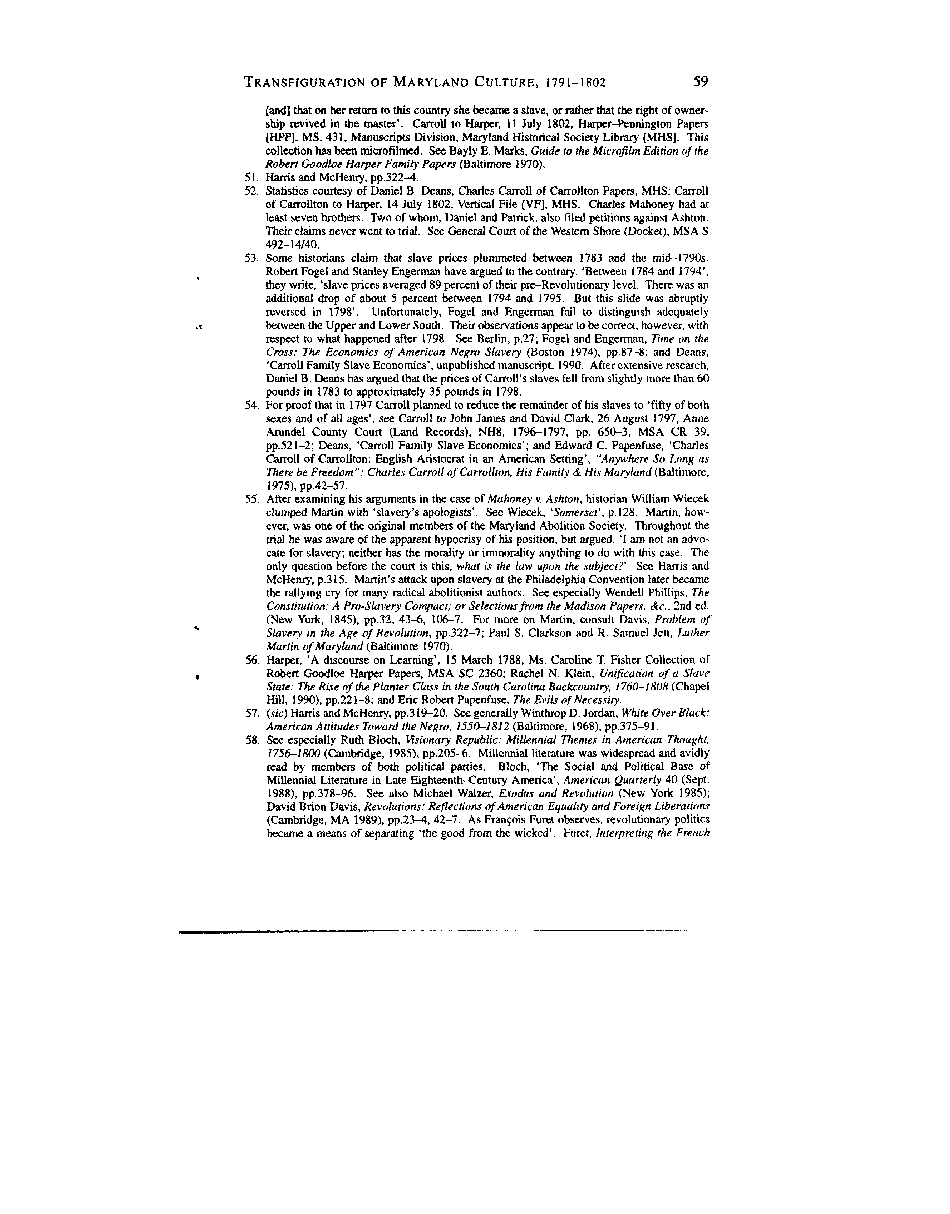|
TRANSFIGURATION OF MARYLAND CULTURE, 1791-1802 59
[and] that on her return to this country she became a slave, or rather that the right of owner-
ship revived in the master'. Carroll to Harper, 11 July 1802, Harper-Pennington Papers
[HPP], MS. 431, Manuscripts Division, Maryland Historical Society Library [MHS]. This
collection has been microfilmed. See Bayly E. Marks, Guide to the Microfilm Edition of the
Robert Goodloe Harper Family Papers (Baltimore 1970).
51. Harris and McHenry, pp.322-4.
52. Statistics courtesy of Daniel B. Deans, Charles Carroll of Carrollton Papers, MHS; Carroll
of Carrollton to Harper, 14 July 1802, Vertical File [VF], MHS. Charles Mahoney had at
least seven brothers. Two of whom, Daniel and Patrick, also filed petitions against Ashton.
Their claims never went to trial. See General Court of the Western Shore (Docket), MSA S
492-14/40.
53. Some historians claim that slave prices plummeted between 1783 and the mid-1790s.
Robert Fogel and Stanley Engerman have argued to the contrary. 'Between 1784 and 1794",
they write, 'slave prices averaged 89 percent of their pre-Revolutionary level. There was an
additional drop of about 5 percent between 1794 and 1795. But this slide was abruptly
reversed in 1798'. Unfortunately, Fogel and Engerman fail to distinguish adequately
between the Upper and Lower South. Their observations appear to be correct, however, with
respect to what happened after 1798. See Berlin, p.27; Fogel and Engerman, Time on the
Cross: The Economics of American Negro Slavery (Boston 1974), pp.87-8; and Deans,
'Carroll Family Slave Economies', unpublished manuscript, 1990. After extensive research.
Daniel B. Deans has argued that the prices of Carroll's slaves fell from slightly more than 60
pounds in 1783 to approximately 35 pounds in 1798.
54. For proof that in 1797 Carroll planned to reduce the remainder of his slaves to 'fifty of both
sexes and of all ages', see Carroll to John James and David Clark, 26 August 1797, Anne
Arundel County Court (Land Records), NH8, 1796-1797, pp. 650-3, MSA CR 39,
pp.521-2; Deans, 'Carroll Family Slave Economies'; and Edward C. Papenfuse, 'Charles
Carroll of Carrollton; English Aristocrat in an American Setting', "Anywhere So Long as
There be Freedom": Charles Carroll of Carrollton, His Family & His Maryland (Baltimore,
1975), pp.42-57.
55. After examining his arguments in the case of Mahoney v. Ashton, historian William Wiecek
clumped Martin with 'slavery's apologists'. See Wiecek, 'Somerset', p.128. Martin, how-
ever, was one of the original members of the Maryland Abolition Society. Throughout the
trial he was aware of the apparent hypocrisy of his position, but argued, 'I am not an advo-
cate for slavery; neither has the morality or immorality anything to do with this case. The
only question before the court is this, what is the law upon the subject?' See Harris and
McHenry, p.315. Martin's attack upon slavery at the Philadelphia Convention later became
the rallying cry for many radical abolitionist authors. See especially Wendell Phillips, The
Constitution: A Pro-Slavery Compact; or Selections from the Madison Papers, &c., 2nd ed.
(New York, 1845), pp.32, 43-6, 106-7. For more on Martin, consult Davis, Problem of
Slavery in the Age of Revolution, pp.322-7; Paul S. Clarkson and R. Samuel Jett, Luther
Martin of Maryland (Baltimore 1970).
56. Harper, 'A discourse on Learning', 15 March 1788, Ms. Caroline T. Fisher Collection of
Robert Goodloe Harper Papers, MSA SC 2360; Rachel N. Klein, Unification of a Slave
State: The Rise of the Planter Class in the South Carolina Backcountry, 1760-1808 (Chapel
Hill, 1990), pp.221-8; and Eric Robert Papenfuse, The Evils of Necessity.
57. (sic) Harris and McHenry, pp.319-20. See generally Wimhrop D. Jordan, White Over Black:
American Attitudes Toward the Negro, 1550-1SJ2 (Baltimore, 1968), pp.375-91.
58. See especially Ruth Bloch, Visionary Republic: Millennial Themes in American Thought,
1756-1800 (Cambridge, 1985), pp.205-6. Millennial literature was widespread and avidly
read by members of both political parties. Bloch, "The Social and Political Base of
Millennial Literature in Late Eighteenth-Century America', American Quarterly 40 (Sept.
1988), pp.378-96. See also Michael Walzer, Exodus and Revolution (New York 1985);
David Brion Davis, Revolutions: Reflections of American Equality and Foreign Liberations
(Cambridge, MA 1989), pp.23-4, 42-7. As Francois Furet observes, revolutionary politics
became a means of separating 'the good from the wicked'. Furet, Interpreting the French
�
|

